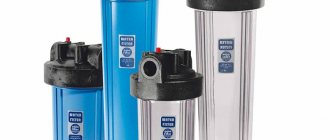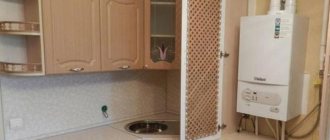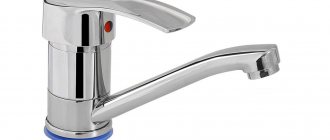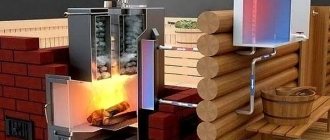Water heaters are becoming increasingly popular in our everyday life. To prevent circumstances from catching us at the wrong moment, we strive to predict all situations.
Warm water shutdowns have become commonplace for city residents. In the private sector, the problem of water heating has never disappeared. It is for such cases that geysers are suitable.
- 2 Ignition of the column
- 3 Type of combustion products removal
- 4 Power
- 5 Safety in use
- 6 Features of domestic systems
- 7 Neva Maintenance
Types of devices
A geyser is a water heating device.
Gas is the main source of energy. The main criterion for choosing a geyser is the characteristics of the device, its quality and price.
Conventionally, according to technical characteristics, speakers can be divided into types:
- by type of ignition;
- by type of chimney;
- by power (on which the volume of heated water depends);
- on safety;
- to size;
- for additional functions.
As for the quality of the product, the popularity and fame of the brand can be decisive. On the domestic market, NEVA is a quality manufacturer. This is confirmed by many reviews of the product. The quality of components and assembly guarantees the reliability of the device.
Ignition of the column
By igniting the column we mean igniting the gas, namely the method in gas columns is:
- manual ignition;
- piezo ignition;
- electronic;
- microturbine.
Manual ignition is a rarity for modern speakers. Older models required matches to ignite the gas. Today such models are rare.
Piezo ignition. By analogy with piezo electric stoves, to ignite the gas you need to press a button on the column panel. This method is still used in modern models.
Electronic. The most convenient and popular way. Reliability and economical gas consumption make such models a little more expensive. By analogy with a car, a spark is created by a small battery; batteries are often used. The NEVA 4511 column belongs to this model range.
As for microturbines, the current in them is generated by a hydrodynamic generator controlled by a water flow. The cost of such copies is much higher.
Columns with electric ignition are easy to use. The gas is ignited automatically when you open the water tap, thereby saving gas consumption.
Design and principle of operation of the Neva 4511 model
The Neva gas water heater, which is described in the article, according to buyers, has fairly simple controls, is safe to use and does not have a constantly burning pilot flame. As for ease of control, this characteristic is expressed in the presence of a liquid crystal display, as well as a temperature controller.
The device also has a modern control panel. Operation of the unit is completely safe, because the instantaneous water heater has an inspection window that provides control over the presence of a flame. Consumers also purchase the Neva gas water heater for the reason that when the tap is opened, the automatic operation of the device stops, which is very convenient from a safety point of view.
Read more: TOP best rodent and insect repellers
It is impossible to repair a household appliance yourself without knowing how it functions and what it consists of. Unlike old-type water heaters, this series of geysers is equipped with a controller and electric ignition, which makes it possible to remove the constantly burning pilot light. Otherwise, the design remained quite simple and maintainable. It consists of the following main elements:
- Housing with hinges for wall mounting.
- Diffuser – a collection of combustion products with a chimney pipe.
- Copper heat exchanger.
- Gas burner device.
- Water node.
- Membrane actuator (so-called frog).
- Gas valve with an electromagnet connected by a common rod to the water unit.
- Controller.
- Microswitch for supplying power to the electronic unit.
- Water supply pipes.
- Ignition electrode.
- Flame sensor (ionization).
- Additional electrode for igniting the burner.
- The tap is a flow regulator.
- Adjustment of combustion intensity and heating temperature.
- Connecting a draft sensor installed inside the diffuser.
- Compartment for batteries (batteries).
The diagram above shows the structure of the Neva gas water heater with digital designations of parts corresponding to the list.
Automatic switching on and heating are controlled by the water unit together with the controller, and a solenoid valve connected to a draft sensor is responsible for the safe supply of gas. The operating algorithm of a water heating device looks like this:
- After opening the hot water tap, pressure arises at the inlet of the “frog”, acting on the rubber membrane of the unit. It moves the rod, which opens the gas valve and closes the microswitch contacts.
- When the electrical circuit is closed, power from the batteries is supplied to the controller. It gives 2 commands simultaneously: open the solenoid valve to allow gas to pass through and create a spark at the ignition electrodes. As a result, the burner ignites.
- The flame sensor detects the appearance of fire and transmits an impulse to the electronic unit, which interrupts sparking. The heater goes into operating mode.
- When the valve on the mixer is closed, the pressure in the network disappears and the spring pushes the “frog” membrane back, simultaneously closing the mechanical gas valve. The limit microswitch is triggered and the controller is deprived of power, and with it the electromagnet. The fuel supply stops and the burner goes out.
Type of combustion products removal
Atmospheric speakers are available for sale.
They discharge combustion waste directly into chimneys. The branded range of NEVA speakers is represented by VPG models from series 10 to 14, in various modifications.
Turbine columns are not connected to the chimney; they take oxygen for combustion from outside and throw combustion products there. They are intended for installation on any floor of a building in houses without chimneys. The higher price is justified by the ease of their use, since chimneys are much more expensive to build.
Power
The power of an instantaneous water heater is determined by the volume of water it can heat.
To heat large quantities of water you will need a powerful unit. Based on their power, speakers can be divided into:
- power from 17 - 20 kW (small speakers);
- from 20 - 26 kW (average);
- from 26 – 28 (high power).
The NEVA column model 4511 consumes 21 kW, but produces up to 11 liters of hot water per minute. For an approximate determination of liters per minute, take a look at this table:
| Power in kW | Consumption at water temperature 50 degrees Celsius | Consumption at water temperature 25 degrees Celsius |
| 17 | Up to 5 l/min | Up to 10 l/min |
| 21 | Up to 7 l/min | Up to 13 l/min |
| 28 | Up to 8 l/min | Up to 16 l/min |
The NEVA 4511 column is suitable for two water collection points. If you need to use more points, it is better to take a column with more power. The NEVA 4511 column is the most compact of the entire series and is suitable for small rooms. More powerful NEVA speakers from the Lux series.
Repair
Very often on the Internet you can find requests like “do-it-yourself geyser NEVA 4511 repair.” That is why typical malfunctions and methods for eliminating them yourself will be given below.
Column does not light up
If the column does not light up, there can be many reasons for this. Among them:
- Lack of draft in the ventilation system. The problem can be solved by cleaning the ventilation duct.
- Problems with the power supply (batteries are dead). The problem is solved by replacing the power element.
- Low water pressure in the water supply system. You can independently wash the filters, clean the column from combustion products and replace the membrane on the water unit. If the problem persists, contact the utility service with appropriate inquiries about the reason for the low pressure in the system.
- Incorrect balance between cold and hot water. In this case, you need to adjust the temperature of the coolant produced by the column so that you do not have to mix cold and hot water.
The column turns on with characteristic pops
As a rule, the reason for this is that the ventilation is clogged, the power batteries are discharged, the gas supply is too intense, or the nozzle is clogged. In all these cases, it is recommended to consult a specialist. You can replace the batteries or clean the ventilation ducts yourself.
Water heating is ineffective
If the column turns on, but it does not heat the water to the required temperature, there may be several reasons for this. First, your equipment may not meet your power needs. Secondly, if the column is clogged, it loses performance, and this must be taken into account. You can adjust the hot coolant supply tap and call a specialist from the service center who will clean the equipment.
conclusions
The fact that you can repair the NEVA 4511 gas water heater yourself makes this model a very attractive unit for the Russian buyer. At the same time, the column is inexpensive, functions for decades and does not require special care during operation. Being a universal water heater of domestic production, NEVA 4511 is ideal for use in Russian houses and apartments.
Safety in use
A gas water heater is a high-risk device.
To simplify use and prevent various accidents, the speakers are equipped with additional sensors. Among which:
- Ionization sensor. If the fire goes out, the sensor cuts off the gas supply.
- Additional temperature sensors. They are triggered if the ionization sensor is not working.
- Heating sensor. Monitors the temperature of the flow heater, i.e. regulates the temperature of the entire device, as well as the heating elements.
- A water pressure sensor, the main task of which is to turn on or off the gas supply automatically when drawing water.
- Temperature difference control sensor. A device for increasing and decreasing the water temperature, in case someone additionally opened the water, is implemented in newer Neva Lux models, model 4514, 4513.
- Gas and water pressure sensor. Control the supply of water or gas to the column. If you open a water tap and turn it off, the column will not supply gas automatically.
- Safety valves. Shut off the water or gas supply in case of high pressure in the system.
Model features
Let us highlight a number of advantages that this speaker can please a potential buyer:
- Compact and ergonomic. The dimensions of the unit are very modest and amount to 565x290x221 mm. At the same time, the entire design is maintained in accordance with the best ergonomic standards - a convenient control panel and minimalistic design are characteristic features of the model.
- High performance. The design of the NEVA 4511 geyser took into account the fact that the equipment will work primarily in the difficult conditions of the Russian climate. Because of this, it was made to be hardy, strong, durable and highly productive. In addition, model 4511 is adapted to work in conditions of low pressure in the water supply system, which can be considered an important plus for users in our country, where interruptions of this kind occur quite often.
- Safety and reliability. The unit is equipped with a flame control sensor, which reduces the risk of an unexpected accident hundreds of times.
Features of domestic systems
Geyser Neva Lux
Advertising newsletters often focus on local conditions. The Neva 4511 column is fully adapted to our water supply systems.
This means that when the gas pressure drops below 13 mBar, the column continues to operate.
At the same time, the automation does not allow turning on the device at low pressure. Gas supply in our territorial latitudes is a secondary problem. The main task is to control water pressure.
An important advantage of the Neva and Neva Lux columns is the replaceable heat exchanger. Instead of buying a new speaker, it is enough to purchase an accessory part. It costs from 3,500 to 4,500 thousand rubles, depending on its type. New models are equipped with a copper heat exchanger; this material is resistant to corrosion, but salt and scale deposits remain a problem.
Malfunctions of the Neva gas water heater: design, errors, do-it-yourself repairs
Vyacheslav S 11/15/2018, 11:15 pm
I will share my repair experience. Ten years of flawless flight of the Neva Lux 6014. Apart from the batteries, nothing has changed. And so it began. 1. Water dripped in the area of the microswitch. 2. When turned on, it goes to maximum heating mode. Naturally overheating, L0 lights up. It is not clear what mode it operates in, but it will heat up to 60, then cool down to 35. And this saw continues. When you wash, you seize moments so as not to get burned. Treatment began with repair of the water unit. The repair kit consists of a membrane, a rod, an O-ring, a plastic assembly with lubricant filler and a tube of lubricant. Pleasure for about 1500 rubles. You can get it cheaper, but that set only contains a membrane and a ring. Don’t regret it, buy a complete set, because if it drips, you’ll have to change the ring, but to get to it, you’ll have to pull out the plastic assembly with the stuffing. Over the course of 10 years, the lubricant in the assembly has disappeared somewhere, which is why the ring has worn off. When you pull it out, most likely (90 percent chance) this plastic assembly will break and you will be left with a broken trough, without lubrication of the rod. Everything is put back together, you fill the new unit with grease, insert the ring into its place, stick the rod in and put the unit on the rod, pressing the ring. Replace the leaky membrane. Everything seems to be working. But no, the “saw” is repeated again. In my head I thought “the electronic unit must have gone crazy, since the gas immediately turns on full, or the temperature sensor is acting up, or the pressure is high, or...” Stop. There is another device that is supposedly Japanese and should not break, but not ours. GAS UNIT. It is removed in the same way as the water unit, only from the other side. BE SURE TO SHUT OFF the gas supply to the column with the valve (if you don’t shut it off, someone will open the hot water and the gas will flow into the apartment at full speed, even without a battery. An explosion is guaranteed. Remove the battery. Disconnect the plugs from the valves (you won’t mix them up during assembly because the color of the supply wires and the connection points on the valves are the same color), unscrew the ground wire and the outlet to the wick (do not lose the gasket, it is better to immediately pull it out and put it aside). Two mounting screws (thanks for making them easily accessible) and the knot in your hands. Pull it through with an asterisk all the screws are around the perimeter of the membrane. Believe me, they are stretching. We unscrew each valve (one at a time). We examine it under a microscope (or glasses with strong optics). One valve is normally open, the other is closed. You can see a small rubber plug on the stem, which is pressed against the tubular nozzle. Over the years, all sorts of nasty things accumulate at the point of contact between the rubber band and the nozzle (well, this is the kind of gas we have, not for Japan) and the valve begins to stick or etch. We very carefully wipe the place of contact, the rubber band itself and the nozzle with a cotton swab and alcohol. We examine it again under a microscope so that there are no fibers left. And dirt in the form of small chips. We wipe the valve seats with O-rings. Don't lose the little ring under one of the flaps. By very lightly pressing the plate holding the rubber stopper, we check whether it is sticking. It should come off very easily without any jolts or clicks. The other valve, normally closed, going to the wick, is also cleaned with alcohol. We check by trying to suck air through the outlet hole. A vacuum must be created and maintained. We assemble carefully and tighten the valve fasteners. There are two rubber rings on the springs in the outer part of the assembly. Big and small. We wipe them with alcohol. Lubricate the O-ring on the seat with silicone grease. I tried to wipe the place where the large ring presses inside the block, where the main flow of gas comes from (between the water and gas blocks). We collect carefully. Do it slowly so as not to damage the O-ring. Don't forget about the seal. ring at the outlet of the valve to the wick. Without installing the battery, open the gas. Let's listen. Doesn't hiss. We open the water several times. We listen and smell. Gas should not come out anywhere. We put the battery in and open the water again several times. It won't light up the first time. The gas will fill the unit and only then will the wick gently light up and turn on NOT FULL gas. Smoothly add gas if necessary. And no burns. It stopped lighting up completely. HOORAY!!!
Answer










